How to Run Without Knee Pain:
Essential Strategies for Runners Over 30, Part 1 of 3:

By Dr. Jerry Yoo, Founder Next Level Physio
Part 1 - Key Takeaways:
1. How you land can make all the difference
2. Track your cadence
3. Use your smartphone to record your runs outdoors and on the treadmill
Running is a passion for many of our Fleet Feet Raleigh runners, offering not only many physical health benefits, but also an effective way to clear your mind, get a dopamine boost, provide mental clarity and a sense of achievement.
As a running physio specialist, knee pain is a very common issue we treat in runners over 30. Whether it’s from a meniscus tear, arthritis, or IT band pain, knee pain can often sideline runners for weeks to months at a time.
But, it doesn’t have to be this way.
With the right techniques and adjustments, running can remain a lifelong activity that is both enjoyable and free from pain.
In this 3 part series dedicated towards chronic knee pain in runners, I’ll be reviewing tips and strategies to both recover from chronic knee pain that I have used to successfully treat runners, even if you’ve had physical therapy or surgery, AND minimize the risk of knee pain if you're a runner over 30 and have never had knee pain but want to stay ahead of it.
Soft Landings to Cushion the Blow
The Science of Impact
Every time your foot hits the ground while running, a significant amount of impact force travels through your body, predominantly absorbed by your knees and other joints. For a runner weighing 100 pounds, for example, each knee could be subjected to between 300 to 700 pounds of force per stride. Over time, this can lead to wear and tear unless managed effectively.
Why Soft Landings?
The concept of landing softer while running isn't just about reducing noise—it's about reducing the impact your body absorbs. By adjusting how you land, you can significantly decrease the stress placed on your knees, which in turn can help mitigate pain and reduce the risk of injury.
“Quiet feet” Stationary Drill
This drill will help you understand the contrast in force exerted on your knees and teach your body how to naturally adjust to a softer landing.
Start by running in place and stomping your feet for 15 seconds to deliberately feel the high impact. This is what you shouldn’t do, but I want to help bring some awareness to what you may already be doing!
Now, try to run as quietly as you can in place. You’ll have to engage muscles that you never have before, so it often feels awkward at first.
Perform for 30 seconds x 5 with a 10 second rest. Repeat for 1-2 more rounds.
Add this stationary drill to your warm-ups and if you feel ready, start to run for 30 seconds at a time with the same “quiet feet.” This will get easier over time!
Other Running Drills to Practice during your warm ups:

1) High Knees Drill:
This drill emphasizes lifting your knees and lightly tapping the ground with the balls of your feet. It helps develop a feel for lighter landings and increases your cadence.
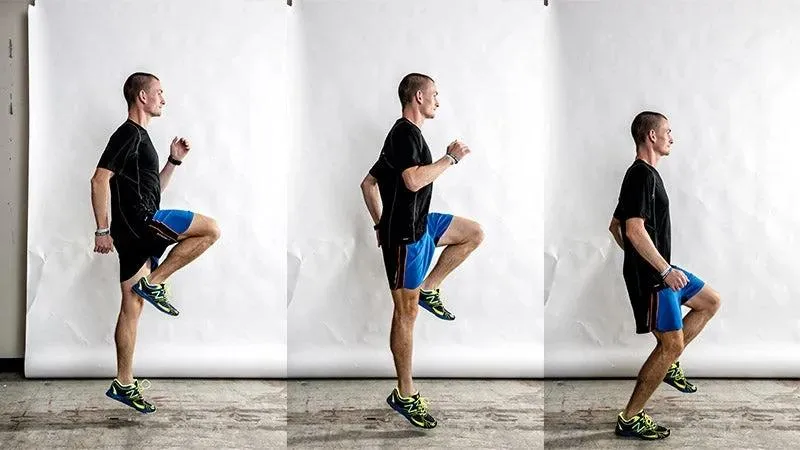
2) Skipping Drills:
Skipping isn't just for kids; it's a fantastic way to learn how to land softly. The playful nature of skipping naturally encourages lighter footfalls and helps build the muscle memory needed for softer landings while running.

3) Barefoot Running Drills:
Occasionally running short distances barefoot on a soft, safe surface or on the track can enhance your proprioception (sense of body position) and encourage a more natural foot strike.
Incorporating these techniques into your running routine doesn’t just aim to reduce immediate discomfort but also serves as a long-term strategy to preserve your joints and enable you to continue running into your 40’s and beyond.
By focusing on soft landings, you protect your knees and contribute to a healthier, more sustainable running practice.
Rethinking Gait and Running Form
Many runners assume their running form is set in stone, but this couldn’t be further from the truth. Small adjustments in how you run can lead to significant improvements, helping you run faster, reduce effort, and protect your joints in the long run.
While specific equipment and analysis can be helpful, simple changes like focusing on your foot strike or adjusting your stride length can be performed with some professional guidance.
Work with a running coach or physical therapist that specializes in runners to analyze and adjust your running gait. Increasing awareness of foot placement and actively practicing appropriate foot placement during running can help.
We regularly record and review running form with our clients both indoor and outdoors, which can help identify when the landing base is too narrow.
Visual feedback is a powerful tool for correcting form in real time. Many of our running clients are surprised by how they look when they run, which helps them to see the areas of opportunity that can help them run pain-free and/or faster for longer periods of time.
The Power of a Slight Forward Lean
Another inefficient habit is running completely upright. Observing runners, you’ll notice that some appear to bounce vertically, wasting precious energy. By incorporating a slight forward lean from your ankles (not your waist), you harness gravity to propel you forward, which not only conserves energy but also minimizes the vertical motion that exacerbates knee stress.
Pro Tip
Aim for an 8-10 degree forward lean. This subtle adjustment allows gravity to work in your favor, enhancing your running economy, especially over long distances as well as optimizing for hip extension and propulsion from the glutes.
Addressing Overstriding and Heel Strike: Key Adjustments for Reducing Knee Pain
In addition to strengthening the gluteal muscles, it is crucial for runners, particularly those over 30, to understand and adjust their running mechanics to prevent knee pain. Two common biomechanical issues that can lead to increased stress and injury are overstriding and heel striking.
The Impact of Overstriding
Overstriding occurs when a runner's foot lands too far ahead of their center of gravity. This not only creates a “braking” force with each step but also increases the impact transmitted up through the legs to the knees. When the foot lands well in front of the body, it usually does so with an extended knee, which can lead to excessive forces being absorbed directly by the knee joint, rather than being distributed throughout the muscles of the leg.
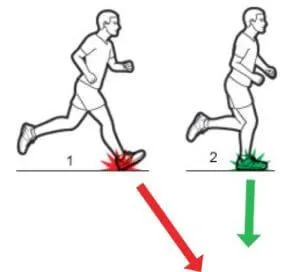
Adjusting Overstriding
To correct overstriding, runners should focus on increasing their cadence (the number of steps taken per minute). A higher cadence typically encourages a landing closer to the runner’s center of mass, which reduces the impact on the knees. Work up to a cadence of around 170-180 steps per minute, which is often recommended for optimal efficiency and reduced injury risk.
Heel Striking and Overstriding
Heel striking refers to landing on the heel first with each step, which often goes tandem with overstriding, and can contribute to knee pain.
This landing pattern, when excessive, can send a significant shock through the heel, up the leg, and directly into the knee joint. Because the leg tends to be straighter when the heel hits first, the natural shock absorbers (the muscles and tendons) are less effective, placing more stress on the knee.
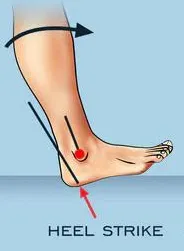
Transitioning Away from Heel Striking
Transitioning to less of a heel strike can help reduce the impact on the knees. This doesn't mean runners have to change their strike completely, but rather make slight adjustments to land more softly and under their center of gravity. This shift can be facilitated by focusing on softer landings and practicing running drills that encourage a softer landing as described above.
Narrow Landing Base Gait
When a runner has a narrow landing base, it means their feet land too close to the midline of their body and in many instances, cross the midline. This often results in several biomechanical challenges.
A narrow landing base can significantly contribute to knee pain, largely due to the biomechanical imbalances it creates. It forces the knee to compensate for the lack of lateral stability. The knee may buckle or rotate inward (a movement known as valgus) under the stress, particularly if the gluteal and hip stabilizer muscles (like the gluteus medius) are weak or if the position of the pelvis is not ideal.
This inward buckling and internal rotation may put excessive stress on the medial (inner) structures of the knee, including the medial collateral ligament (MCL) and the medial meniscus, which can lead to pain and injury over time.
This uneven force distribution can also cause issues like gluteal tendinitis/bursitis (pain on outside of hip), patellofemoral pain syndrome (runner's knee), where pain is felt around the kneecap, IT band pain,where pain is felt on the outside of the knee, and meniscus pain, which is felt “inside” the knee.
When the feet land too close together, the body's ability to maintain an effective and efficient running form is reduced. Runners may experience a decrease in balance and stability, leading to compensatory movements that not only reduce running efficiency but also increase the risk of injury by altering the natural gait pattern.
Pro tips to Address a Narrow Landing Base
To mitigate the issues caused by a narrow landing base and reduce knee pain, runners can employ several strategies including running drills and strength work.
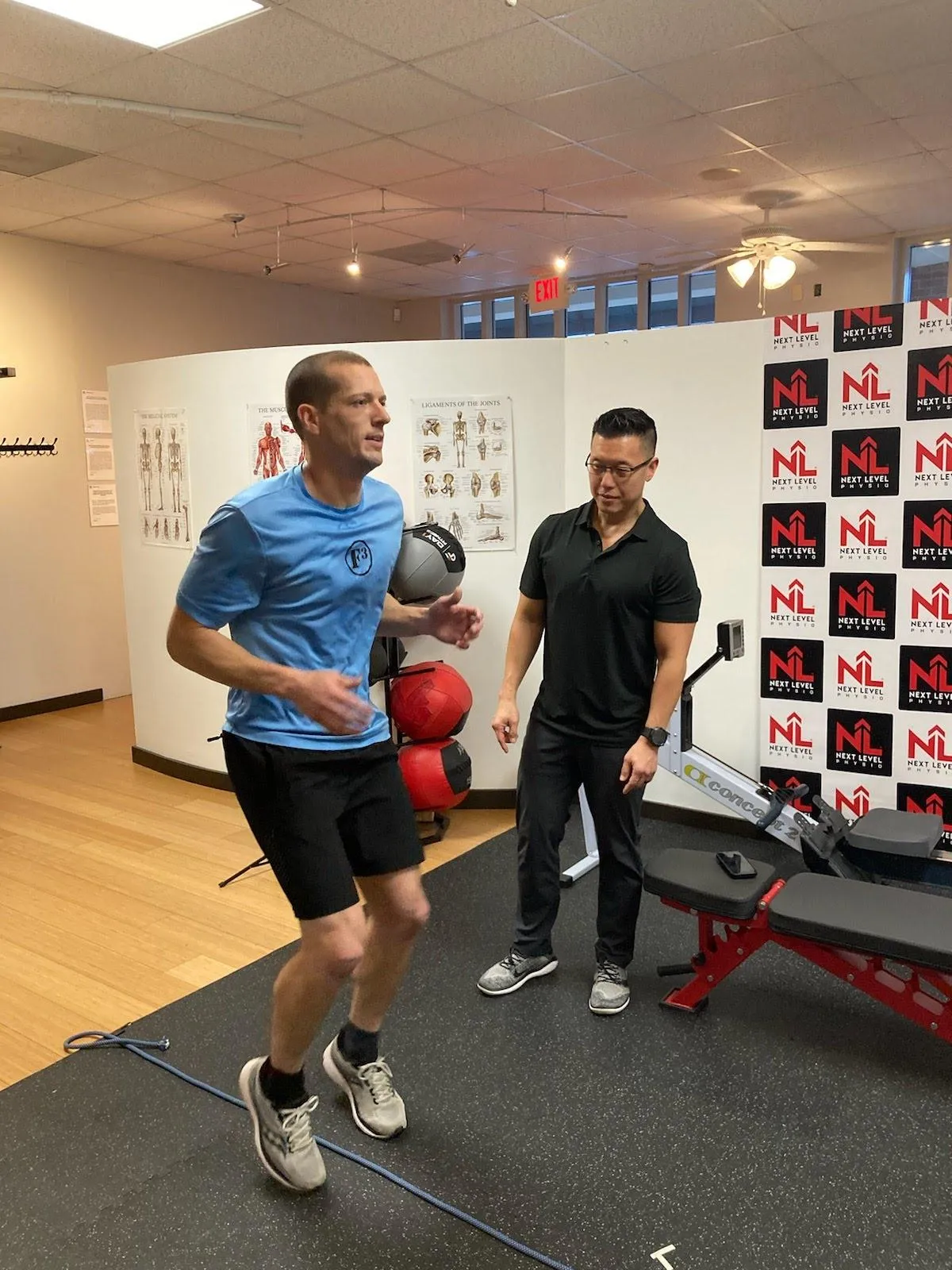
Rope Drill:
Placing your feet on either side of a rope or straight object (even a lane line in a parking lot will suffice), and run in place, while being mindful of your foot placement (this drill can be combined with the quiet feet drill). The goal of this drill is to help you feel the width between your feet as you land.
As far as strength, a focused program incorporating the hip abductors and external rotators, including the gluteus medius and minimus and the deep gluteals is critical for runners with knee pain.
Exercises like side-lying leg raises, clamshells, fire hydrants, curtsy lunges, romanian deadlifts, and squats with both double and single leg support are staples in our running strength program. Stay tuned for Part 2 to learn how to build a running strength program and perform each exercise CORRECTLY!
Track Your Cadence
As mentioned above, while intentionally running with a softer landing can reduce impact, increasing your running cadence (the number of steps you take per minute) can also encourage softer landings and reduce overstriding.
With a higher cadence (between 170-180 beats per minute), each foot spends less time in the air, more time under your body, and hence, less force is generated upon landing.

How to track your cadence:
If you have one of the newer Garmin models, there’s a built-in metronome in the settings. If you don’t have one of these watches, download a metronome app (we use the Pro Metronome app, which is free) and set the beat to 170-180 while you run, so that your foot lands in sync with each beat.
I often get asked if cadence matters much during slower paced runs and the answer is YES! Keeping cadence constant, speed is governed by the amount of relative forward lean and how high your knee comes up with each step. Said differently, if you’re on a slow run, your forward lean will be a little less and your knee height will be less, but your cadence should remain in the same range of 170-180.
Surface Selection
Where you run can also impact the force you feel with each step. Mixing in running on softer surfaces such as grass, dirt trails, or running tracks can naturally decrease the amount of force your knees have to endure compared to harder surfaces like concrete.
Final notes
Having your running form recorded and reviewed can help identify any potential problems that may be contributing to your knee pain. As discussed, an overstriding or narrow landing base can lead to significant knee pain in runners by causing biomechanical imbalances and increased stress on the knee.
Addressing running form issues through drills, increasing cadence, and adding strength training can help reduce knee pain and improve overall running performance.
Next Steps for Runners Over 30 With Knee Pain
If you've tried general advice and are still struggling with knee pain, or if you're unsure about modifying your training regimen, consider consulting with a physical therapy specialist who understands the unique needs of runners over 30. They can provide personalized guidance and support tailored to your specific conditions.
Running should be a joy, not a source of pain. By adjusting how you run, adding strength training, and considering your overall form, you can continue to enjoy running well into your 40s and beyond without knee pain. Remember, the key to longevity in running is not just persistence but also smart, informed practice. Happy running!
Dr. Jerry Yoo is the Founder of Next Level Physio.
He has worked with runners and triathletes for over 25 years, and is a clinical running research partner with Rutgers University, Dr. Jerry is an expert at helping athletic men and women over 30 get back to what they love to do.
He can be reached directly at
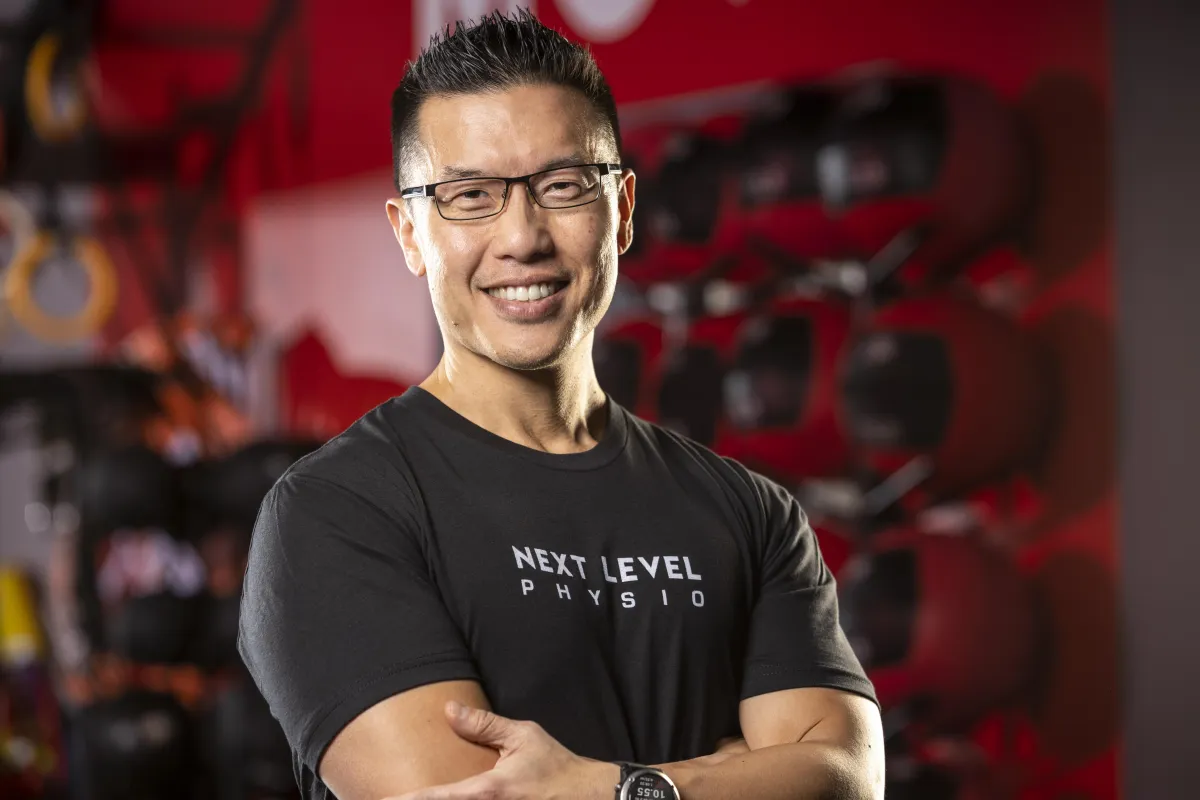
Post Address and Mail
Email: info@nlphysio.com
Address
1055 Darrington Drive
Cary, NC 27513
Get In Touch
Hours
Mon - Fri: 7 am- 6:00 pm
Sat: 8:00 am - 12:00 pm
Sun: By Appointment Only
Phone Number:
919-650-4633
Office: 1055 Darrington Drive
Cary, NC 27513
Call 919-650-4633
Email:info@nlphysio.com
Site: www.nlphysio.com
